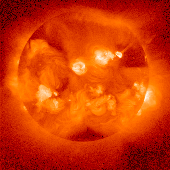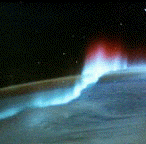
and on humanity"
The Sun-Earth Connection program is one of the four principal science themes of NASA's Office of Space Sciences. It encompasses the scientific disciplines of solar and heliospheric physics, magnetospheric physics, and aeronomy (the study of the ionized and neutral upper atmospheres of the Earth and other planets). The predominant, though by no means exclusive, emphasis of the Sun-Earth Connection theme is on the study of solar system plasmas and the current systems and magnetic fields associated with them.
A major focus of the Sun-Earth Connection program is, as its name implies, on elucidating the physical processes that link the Sun and the Earth. Specifically, research supported by the Sun-Earth Connection program seeks to understand the transfer of energy from the Sun to the Earth and the response of the Earth's coupled magnetosphere-ionosphere-atmosphere system to this energy transfer.
 The
Sun's energy output varies on time scales of seconds to centuries
to eons and takes two principal forms: electromagnetic radiation and the
emission of charged particles. The solar electromagnetic radiation
varies the least at visible wavelengths (the regime that most
directly affects weather and climate) and varies the most at short
(ultraviolet and X-ray) and radio wavelengths. The charged
particles that carry a portion of the Sun's energy include both the
relatively low-energy plasma of the solar wind and high-energy
particles, such as solar energetic protons, which have been
accelerated to velocities near the speed of light. The solar wind
varies both recurrently, as a function of the Sun's 27-day rotational
period, and sporadically, in response to violent eruptive events in
the corona, which also accelerate energetic particles to
near-relativistic velocities. An essential requirement for understanding
the Sun-Earth connection is understanding the causes of solar
variability and determining the mechanisms by which the energy
generated in the Sun's core is released into space.
The
Sun's energy output varies on time scales of seconds to centuries
to eons and takes two principal forms: electromagnetic radiation and the
emission of charged particles. The solar electromagnetic radiation
varies the least at visible wavelengths (the regime that most
directly affects weather and climate) and varies the most at short
(ultraviolet and X-ray) and radio wavelengths. The charged
particles that carry a portion of the Sun's energy include both the
relatively low-energy plasma of the solar wind and high-energy
particles, such as solar energetic protons, which have been
accelerated to velocities near the speed of light. The solar wind
varies both recurrently, as a function of the Sun's 27-day rotational
period, and sporadically, in response to violent eruptive events in
the corona, which also accelerate energetic particles to
near-relativistic velocities. An essential requirement for understanding
the Sun-Earth connection is understanding the causes of solar
variability and determining the mechanisms by which the energy
generated in the Sun's core is released into space.
 The Earth
responds to the Sun's varying energy output in different ways. For
example, episodic events such as fast coronal mass ejections,
which occur more frequently near the peak of the 11-year solar
activity cycle, can trigger major magnetospheric disturbances
known as nonrecurrent geomagnetic storms. Associated with such
large storms--and with more moderate recurrent storms as well--are
spectacular auroral displays as well as enhanced fluxes of
energetic particles and ionospheric disturbances that can damage
spacecraft, disrupt communications, and disable power grids. To
take another example, variations over the 11-year solar cycle in the
intensity of the Sun's electromagnetic output at short (X-ray and
ultraviolet) wavelengths significantly affect the chemistry,
structure, and dynamics of the Earth's upper atmosphere, while
longer-term solar irradiance variations may be linked to major
shifts in the global climate.
The Earth
responds to the Sun's varying energy output in different ways. For
example, episodic events such as fast coronal mass ejections,
which occur more frequently near the peak of the 11-year solar
activity cycle, can trigger major magnetospheric disturbances
known as nonrecurrent geomagnetic storms. Associated with such
large storms--and with more moderate recurrent storms as well--are
spectacular auroral displays as well as enhanced fluxes of
energetic particles and ionospheric disturbances that can damage
spacecraft, disrupt communications, and disable power grids. To
take another example, variations over the 11-year solar cycle in the
intensity of the Sun's electromagnetic output at short (X-ray and
ultraviolet) wavelengths significantly affect the chemistry,
structure, and dynamics of the Earth's upper atmosphere, while
longer-term solar irradiance variations may be linked to major
shifts in the global climate.
The societal consequences of variations in the Sun's energy output can be quite significant. They can range from the loss of multimillion-dollar spacecraft to possible social and economic dislocations resulting from regional or global climate change. Thus, developing a detailed, theoretically grounded understanding of the physical processes that constitute the Sun-Earth connection is not only a scientifically compelling aspect of humankind's effort to comprehend the basic workings of Nature. It is of great practical importance and urgency as well, insofar as this understanding makes possible the prediction of geoeffective solar activity and the forecasting of "space weather." In addition to its role in safeguarding technological assets, forecasting space weather is vitally important to NASA's ability to protect astronauts from exposure to harmful fluxes of highly energetic charged particles, both in Earth orbit (Shuttle, Mir) and during eventual interplanetary missions to Mars.
 The
scope of the Sun-Earth Connection theme is much broader than the
investigation of solar-terrestrial relations, however. The program
also supports the study of the space environments and upper
atmospheres of other solar system bodies--planets, comets, and
asteroids. Scientifically interesting and worthy of study in
themselves, these objects also serve as a laboratory for the
comparative investigation of basic plasma physical and
aeronomical processes under varying boundary conditions. Such
comparative studies are of critical importance for achieving the
fundamental physical understanding that is the ultimate goal of the
Sun-Earth Connection program.
The
scope of the Sun-Earth Connection theme is much broader than the
investigation of solar-terrestrial relations, however. The program
also supports the study of the space environments and upper
atmospheres of other solar system bodies--planets, comets, and
asteroids. Scientifically interesting and worthy of study in
themselves, these objects also serve as a laboratory for the
comparative investigation of basic plasma physical and
aeronomical processes under varying boundary conditions. Such
comparative studies are of critical importance for achieving the
fundamental physical understanding that is the ultimate goal of the
Sun-Earth Connection program.
A further focus of the Sun-Earth Connection theme is on characterizing the dynamics, properties, and structure of the solar wind as it blows through interplanetary space and interacts with the local interstellar medium to form the heliosphere. Of special interest is the nature of the interface between the solar wind and the interstellar medium and the physical processes that occur there. Particularly exciting is the prospect of observing that interface directly and then of penetrating the heliospheric envelope to sample, for the first time, the interstellar medium itself.
 The
domain of the Sun-Earth Connection program thus extends to the
very limits of the Sun's influence--to the frontier where our solar
system encounters the plasmas and neutral gases of the interstellar
medium. The relevance of the physical understanding achieved
through the study of solar system plasmas extends even further, for
the plasma processes that we study in our solar system--shock
formation, particle acceleration, and magnetic reconnection--are of
fundamental importance in other astrophysical settings. It is only
in our solar system, however, that these processes can be studied
directly, through in-situ measurement and close-up imaging. The
significance of this fact is stressed in a 1995 report
by the Space
Science Board of the National Research Council: "Explanations of
physical phenomena in astrophysical objects that will remain
forever inaccessible to direct observation rest heavily on insights
obtained through studies of solar system plasmas accessible to in
situ observations."
The
domain of the Sun-Earth Connection program thus extends to the
very limits of the Sun's influence--to the frontier where our solar
system encounters the plasmas and neutral gases of the interstellar
medium. The relevance of the physical understanding achieved
through the study of solar system plasmas extends even further, for
the plasma processes that we study in our solar system--shock
formation, particle acceleration, and magnetic reconnection--are of
fundamental importance in other astrophysical settings. It is only
in our solar system, however, that these processes can be studied
directly, through in-situ measurement and close-up imaging. The
significance of this fact is stressed in a 1995 report
by the Space
Science Board of the National Research Council: "Explanations of
physical phenomena in astrophysical objects that will remain
forever inaccessible to direct observation rest heavily on insights
obtained through studies of solar system plasmas accessible to in
situ observations."
Our solar system is thus an indispensable laboratory for the investigation of astrophysical plasmas, and the research conducted in it under the aegis of the Sun-Earth Connection is vital if we are to advance our knowledge and understanding of the plasma universe. Further, what we learn through the comparative study of planetary space environments about the role of magnetic fields and charged particle bombardment in the evolution of planetary/satellite atmospheres and surfaces may help us to address fundamental questions about the possible habitability of extrasolar planets/satellites as well as about the conditions for the origin and evolution of life in our own solar system.
OSS Science Themes
On February 29, 1996, OSS's three science divisions, Space Physics, Astrophysics, and Solar System Exploration, were merged into a single space science division. The OSS reorganization was part of an effort to "re-invent" NASA in the face of shrinking budgets. Rather than being broken down along disciplinary lines, the integrated OSS space science program is now organized around four major themes. A Science Director is responsible for each theme area. The four Science Directors and the Associate Administrator constitute the Science Board of Directors, which "provides the programmatic and intellectual leadership of OSS, integrating the resources of OSS in a consensual process to reach goals specified in each of the science thematic areas" (W. T. Huntress, Jr., letter dated 11 July 1995).
The four major themes and the responsible Science Directors are:
- Structure and Evolution of the Universe (Alan Bunner)
- Exploration of the Solar System (Juergen Rahe)
- The Sun-Earth Connection (George Withbroe)
- Astronomical Search for Origins & Planetary Systems (Edward Weiler)